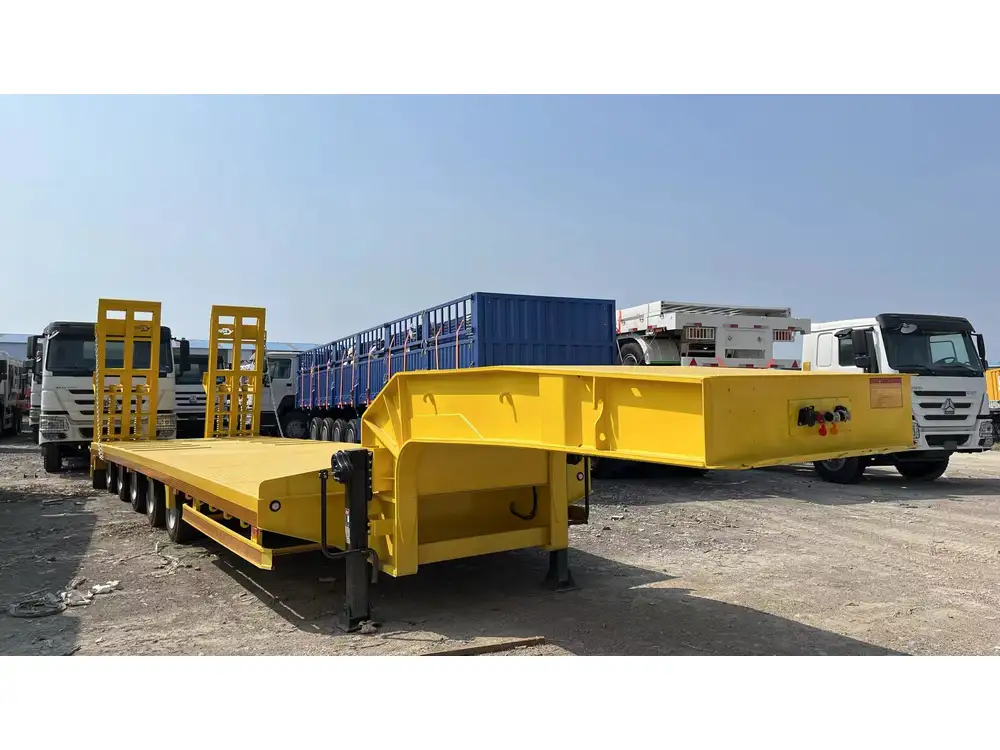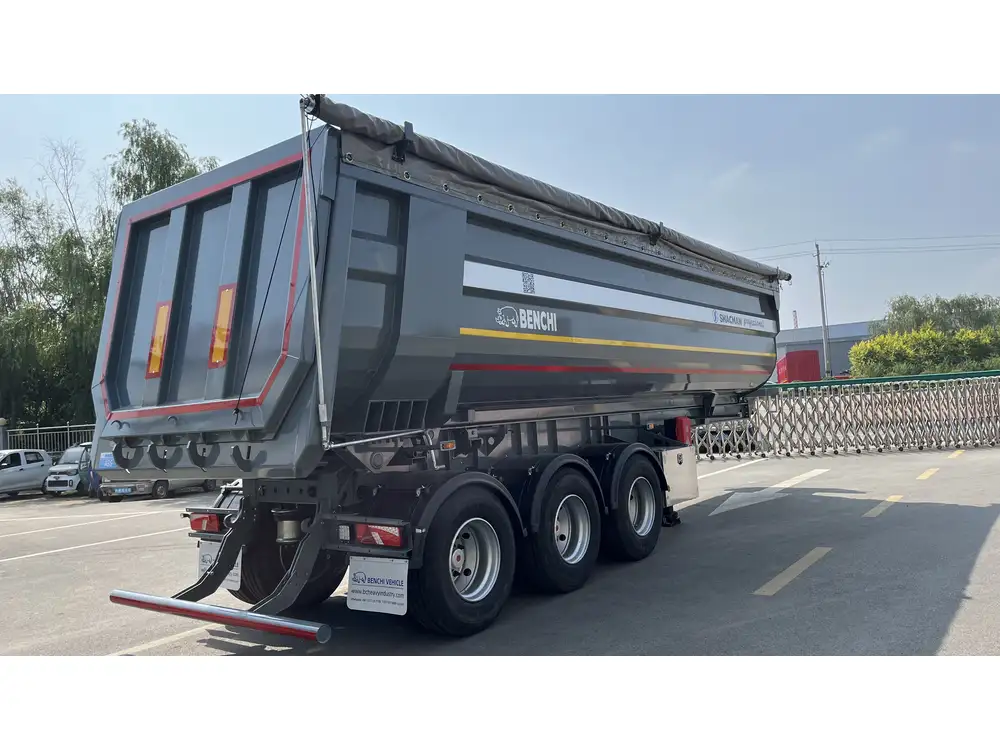Understanding the dimensions of a semi low boy trailer is essential for logistics companies, transportation professionals, and industries relying on heavy hauling. This guide will dissect the specifics of semi low boy trailers, considering width and other dimensions, their applications, variances in design, and regulations that govern their usage.
1. Overview of Semi Low Boy Trailers
Definition and Purpose
Semi low boy trailers are specialized flatbed trailers designed for transporting oversized loads. Their unique construction features a lowered deck, which facilitates the loading and unloading of heavy equipment and allows for a lower center of gravity. This design minimizes the overall height of the load, enabling compliance with legal height restrictions while enhancing stability during transport.
2. Dimensions of Semi Low Boy Trailers
Standard Width Measurements
- General Width: The standard width of semi low boy trailers generally ranges between 8.5 feet (102 inches) and 14 feet (168 inches). Understanding these widths is crucial, especially in the context of state and federal transportation regulations.
| Width Category | Range |
|---|---|
| Standard Trailers | 8.5 feet (102 inches) |
| Wide Load Trailers | Up to 14 feet (168 inches) |
Note: The standard width for most trailers is 8.5 feet, which falls within legal limits for many regions. Anything wider may require permits.
Length and Height Considerations
- Length: Typically, low boy trailers can range from 20 feet to 53 feet in length, although customizable options may be available.
- Height: The height of these trailers can vary based on design, but generally, a low boy trailer has a height of about 18 to 24 inches, excluding the loaded equipment.

3. Detailed Examination of Low Boy Trailer Design
3.1 Types of Low Boy Trailers
- Single Axle Low Boys: Ideal for lighter loads, these trailers simplify maneuverability in tight residential areas.
- Tandem Axle Low Boys: These are more versatile, offering increased weight distribution and capacity, accommodating larger loads efficiently.
- Tri-Axle Low Boys: Designed for maximum load capacity, tri-axles provide enhanced stability, making them suitable for transporting extremely heavy constructions and machinery.
3.2 Deck Types
- Fixed Deck Trailers: Offer a straightforward structure with a stationary deck height, suitable for standard loads.
- Drop Deck Trailers: Designed with a drop in the deck height, allowing taller cargo to transport without exceeding height limits.
- Beavertail Trailers: Featuring a gradual incline, these trailers enable easy loading and unloading of heavy equipment.

4. Regulations and Compliance
Understanding the regulations surrounding trailer widths is essential for safe and legal transportation. In the U.S., the Federal Highway Administration (FHWA) and state agencies impose specific rules regarding maximum trailer dimensions.
| Aspect | Regulation |
|---|---|
| Maximum Width | 8.5 feet (102 inches) |
| Overwidth Permits | Required for trailers exceeding 8.5 feet |
| Load Height Limit | Generally 13.5 feet |
| Weight Limits (Varies by State) | Typically up to 80,000 lbs on interstate highways |
Additional Compliance Considerations
- State Regulations: Different states have unique rules regarding width and weight. It’s essential to check local laws when transporting loads across state lines.
- Permit Requirements: Exceeding legal size and weight limits usually necessitates specific permits. This includes routes, days, and hours when oversized transportation is allowed.
5. Applications of Semi Low Boy Trailers
Semi low boy trailers are primarily used in the transportation of heavy equipment such as:
- Construction Machinery: Excavators, bulldozers, loaders, and cranes all require low bed trailers to ensure safe transport.
- Agricultural Equipment: Tractors, planters, and harvesters often necessitate a low boy for effective movement.
- Industrial Equipment: Large machinery and components used in manufacturing and production workflows also benefit from low boy transport.

6. Choosing the Right Semi Low Boy Trailer
When selecting a semi low boy trailer, it is crucial to consider several factors based on the specific needs of transportation. Use the following checklist to simplify the decision-making process:
| Factor | Consideration |
|---|---|
| Load Type | Determine if your loads are bulky, heavy, or unusually shaped |
| Weight Capacity | Ensure the chosen trailer can accommodate the load weight needed |
| Axle Configuration | Consider the terrain and distribution of load when selecting axles |
| Deck Height | Ensure the height aligns with your equipment’s loading requirements |
| Custom Features | Evaluate options like ramps, winches, or additional tie-downs |
7. Safety Measures During Transportation
Transporting oversized loads with semi low boy trailers comes with inherent risks. Implementing safety measures can mitigate these risks and ensure safe delivery.
7.1 Pre-Trip Inspection
- Check Tire Pressure: Ensure all tires are at manufacturer-recommended pressures.
- Inspect Load Securement: Use appropriate straps, chains, and binders to secure the load effectively.
- Brake Functionality: Verify that brakes are operational to guarantee sudden stops do not lead to accidents.

7.2 Routes and Hazards
- Identify Low Overpasses: Consider using route planning tools to avoid areas with height restrictions.
- Monitor Weather Conditions: Inclement weather can affect traction and visibility, warranting adjusted travel times.
8. Conclusion
Understanding the dimensions and utility of semi low boy trailers, including how wide they are and their regulatory implications, is crucial for companies involved in heavy transportation. This knowledge streamlines logistics, enhances compliance, and ensures safety during transport. Whether it’s choosing the right trailer for specific loads or adhering to the necessary regulations, by thoroughly engaging with the specifications and applications of semi low boy trailers, companies can optimize their operations and ensure effective transportation solutions.
This comprehensive guide has taken a logical, structured approach to analyzing various dimensions and regulations pertaining to semi low boy trailers while providing insights into their applications and safety measures. With the right understanding and strategic planning, handling oversized loads can be executed with efficiency and safety, proving invaluable for industries reliant on heavy equipment transport.



